Detour (1945 film)
9.2 /10 1 Votes
4/4 Roger Ebert Budget 117,000 USD Country United States | 7.5/10 IMDb 100% Rotten Tomatoes Genre Crime, Drama, Film-Noir Duration Language English | |||||||||||||||||||||||||||||||||
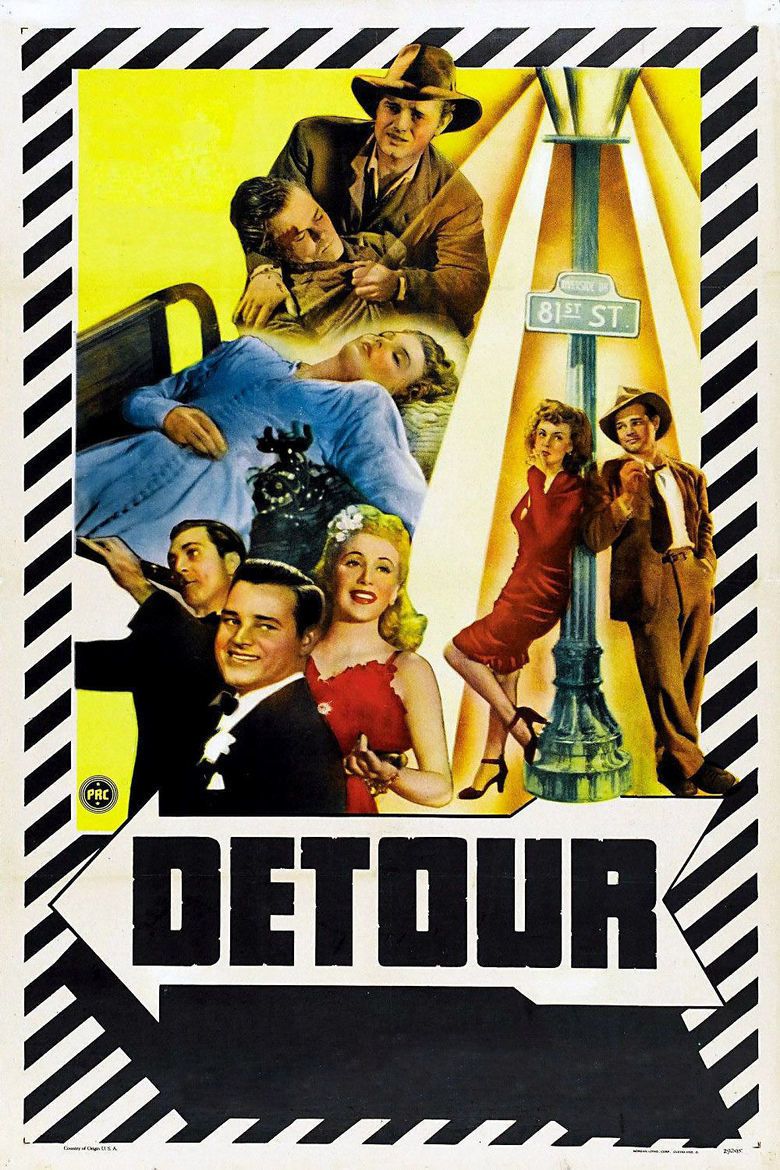 | ||||||||||||||||||||||||||||||||||
Release date November 30, 1945 (1945-11-30) (United States) Based on the 1939 novel Detour: An Extraordinary Tale by Martin Goldsmith Screenplay Martin Goldsmith, Martin Mooney Cast (Al Roberts), (Vera), (Sue Harvey), (Charles Haskell Jr), (Nevada Diner Proprietor), (Holly, Diner Waitress) Similar movies Mysterious Intruder , The Big Sleep , Double Indemnity , The Sniper , The Third Man , The Thirteenth Hour Tagline He went searching for love... but Fate forced a DETOUR to Revelry... Violence... Mystery! | ||||||||||||||||||||||||||||||||||
Detour 1945 film noir drama
In New York, piano player Al Roberts (Tom Neal) laments when his singer girlfriend, Sue Harvey (Claudia Drake), leaves for Hollywood, Calif. When Al gets some money, he decides to hitchhike to California to join Sue. In Arizona, Al accepts a ride with Charles Haskell (Edmund MacDonald), but during a storm in a freak accident, Haskell is killed. Frightened, Al assumes Haskells identity and car, but soon comes upon the mysterious Vera (Ann Savage), who seems to know all about his true identity.
Contents
- Detour 1945 film noir drama
- detour custom movie trailer
- Plot
- Cast
- Production
- Editing
- Censorship
- Reception
- Critical response
- Similar Movies
- Remake
- References
Detour is a 1945 film noir thriller that stars Tom Neal and Ann Savage.
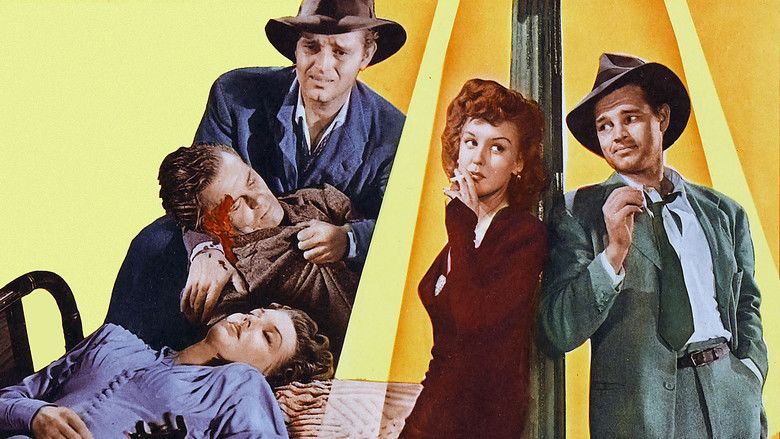
The film was adapted by Martin Goldsmith and Martin Mooney (uncredited) from Goldsmiths novel of the same name and was directed by Edgar G. Ulmer. The 68-minute film was released by the Producers Releasing Corporation (PRC), one of the so-called "poverty row" film studios in mid-twentieth century Hollywood.
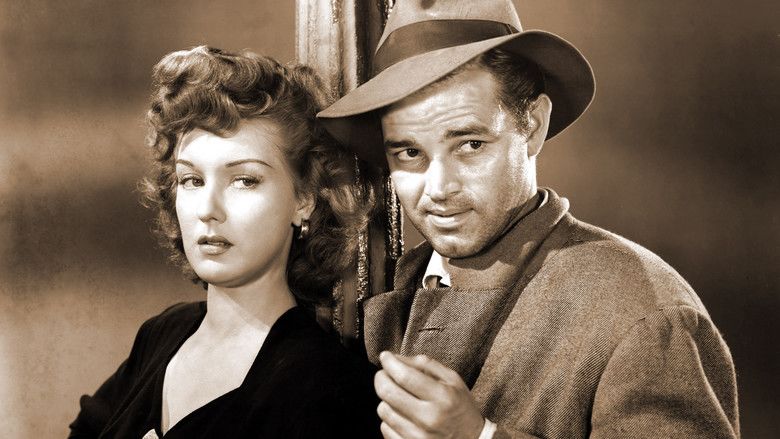
Although made on a small budget with bare sets and straightforward camera work, Detour has gathered much praise through the years and is held in high regard. In 1992, Detour was selected for preservation in the United States National Film Registry by the Library of Congress as being "culturally, historically, or aesthetically significant".

The film has fallen into the public domain and is freely available from online sources. There are many DVD editions.
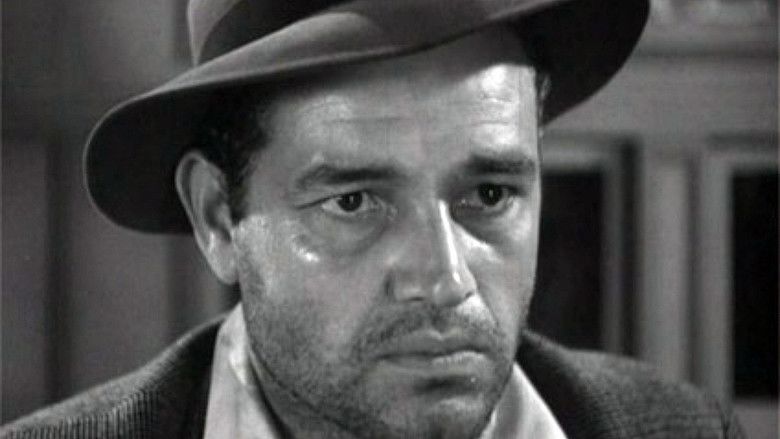
Al Roberts, a New York nightclub pianist, hitch-hikes to Hollywood to meet his girlfriend Sue. The gambler he's riding with, Charles, unexpectedly dies. Afraid the police wouldn't believe the truth, Al takes the man's identity. In a gas station, he gives a lift to Vera, a woman that knew Charles and blackmails Al with tragic consequences.
detour custom movie trailer
Plot
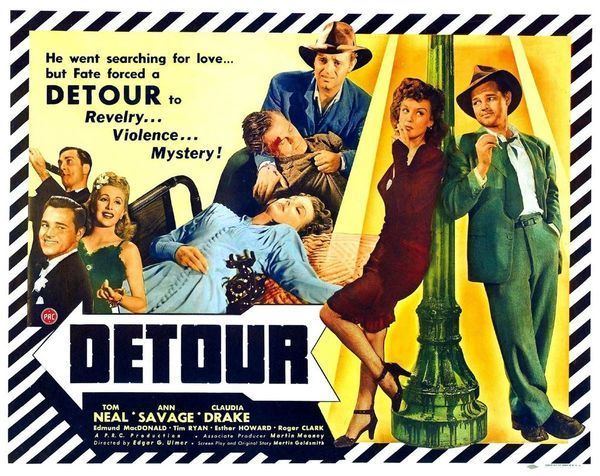
Piano player Al (Tom Neal) is bitter about having to work in a New York nightclub. After his girlfriend Sue (Claudia Drake) leaves to seek fame in Hollywood, he decides to join her. With little money, he has to hitchhike his way across the country.
In Arizona, bookie Charles Haskell Jr. (Edmund MacDonald) gives him a ride in his convertible. Haskell has Al pass him pills several times along the way. That night, Al is driving while Haskell sleeps, when a rainstorm forces Al to pull over to put up the top. Unable to rouse Haskell, Al opens the passenger-side door. Haskell falls out and strikes his head on the ground. Al then realizes the bookie is dead. Fearful that the police will believe he killed Haskell, Al dumps the body off the side of the road, takes Haskells money, clothes and identification, then drives away. After spending the night in a motel, Al picks up another hitchhiker, Vera (Ann Savage), at a gas station. By sheer bad luck, it turns out that the femme fatale had also been picked up by Haskell earlier. She scratched him deeply in the arm and got out after he tried to become too friendly. When Al identifies himself as Haskell, she blackmails him by threatening to turn him in.
In Hollywood, they rent an apartment, posing as Mr. and Mrs. Haskell to provide an address when they go to sell the car. However, Vera learns from a newspaper that Haskells wealthy father is near death and looking for his son, who ran away as a youth after accidentally injuring his friend. Vera demands that Al impersonate Haskell, but Al balks at this notion, pointing out that he knows nothing about the dead man. Back in the apartment, Vera gets drunk, and they begin arguing. She threatens to call the police, running into the bedroom with the telephone and locking the door. She falls into a stupor on the bed, with the telephone cord tangled around her neck. Al tries to break the cord. Then, when he breaks down the door, he sees that he has accidentally strangled her. He goes hitchhiking again, but is picked up by the police.
Cast
Production
In 1972, Ulmer said in an interview that the film was shot in six days. In a 2004 documentary, Ulmer’s daughter Arianne presented a shooting script title page which noted, "June 14, 1945-June 29. Camera days 14." Ann Savage was contracted to PRC for the production of Detour for three six-day weeks. She later said the film was shot in four six-day weeks, with an additional four days of location work in the desert at Lancaster, California. While popular belief long held that Detour was shot for about $20,000, Noah Isenberg, in doing research for his book on the film, discovered that the films actual cost was upwards of $100,000.
Editing
As detailed in Savage Detours: The Life and Work of Ann Savage, great care was taken during the post-production of Detour.
The final picture was tightly cut down from a much longer shooting script, which had been shot with more extended dialogue sequences than appear in the final film. The soundtrack is fully realized, with ambient backgrounds, motivated sound effects, and a carefully scored original musical soundtrack by Leo Erdody. Ulmer and Erdody had previously worked together on Strange Illusion. Erdody took extra pains to underscore Veras introduction with a sympathetic theme, giving the character a light musical shading in contrast to her razor-sharp dialogue, and its ferocious delivery by Ann Savage.
The film was completed, negative cut and printed throughout the late summer and fall of 1945. It was released in November of that year. The total period of pre-production through post-production at PRC ran from March through November 1945.
In contrast, during the period Detour was in post, PRC shot, posted and released Apology for Murder, also starring Ann Savage. Apology was given a shorter production period, a quick sound job, and used library music for the soundtrack. Clearly, Detour was a higher priority to PRC, and the release was well promoted in theaters with a full array of color print support, including a six sheet, standees, hand drawn portraits of the actors, and a jukebox tie-in record with Bing Crosby singing "I Cant Believe That Youre in Love with Me".
With re-shoots out of the question for such a low-budget movie, director Edgar G. Ulmer put storytelling above continuity, such as flipping the negative for some of the hitchhiking scenes. This showed the westbound New York to Los Angeles travel of the character with a right-to-left flow across the screen, but also made cars seem to be driving on the "wrong" side of the road, with the hitchhiker getting into the car on the drivers side.
Censorship
The Hollywood Production Code did not allow murderers to get away with their crimes, so Ulmer got through the censors by having Al picked up by a police car at the very end of the movie, after foreseeing his arrest in the earlier narration.
Reception
Contemporary screenings of Detour were not confined to grindhouse theaters, as might be supposed. In downtown Los Angeles it played at the 2,200 seat Orpheum, in combination with a live stage show featuring the hit Slim Gaillard Trio and the Buddy Rich Orchestra. Business was reported to be excellent despite a transit strike.
Critical response
Detour was well received upon initial release with positive reviews in the Los Angeles Times, Variety and The Hollywood Reporter, among many others. It was released to television in the early 1950s, and ran in syndicated TV markets until the dawn of mass cable systems in the 1980s. TV reviewers casually recommended it in the 1960s and 1970s as a worthwhile "B" movie. During the 1970s, Detour began to be seen as a prime example of "Film Noir", and critics began to write about it at increasingly greater length. During the 1980s, revival houses, universities, and film festivals began to honor Edgar G. Ulmer with retrospective tributes to his work, and public interest in noir films and crime dramas increased with the rise of cable TV screenings and availability on VHS and Laserdisc in home video.
Edgar Ulmer died in 1972, well ahead of the full revival of Detour, and the critical re-evaluation of his career. Tom Neal also died in 1972. Ann Savage made live appearances with the film from 1985 to 2006, increasing public visibility as critical interest and analysis continued to grow.
Critical response to the film today is almost universally positive. Most reviewers contrast the technical shoddiness of the film with its successful atmospherics. Film critic Roger Ebert wrote in his essay for The Great Movies:
"This movie from Hollywoods poverty row, shot in six days, filled with technical errors and ham-handed narrative, starring a man who can only pout and a woman who can only sneer, should have faded from sight soon after it was released in 1945. And yet it lives on, haunting and creepy, an embodiment of the guilty soul of film noir. No one who has seen it has easily forgotten it."
Sight and Sound reviewer Phillip Kemp later wrote:
"Using unknown actors and filming with no more than three minimal sets, a sole exterior (a used-car lot) to represent Los Angeles, a few stock shots, and some shaky back-projection, Ulmer conjures up a black, paranoid vision, totally untainted by glamour, of shabby characters trapped in a spiral of irrational guilt."
Novelists Edward Gorman and Dow Mossman wrote:
"...Detour remains a masterpiece of its kind. There have been hundreds of better movies, but none with the feel for doom portrayed by ... Ulmer. The random universe Stephen Crane warned us about—the berserk cosmic impulse that causes earthquakes and famine and AIDS—is nowhere better depicted than in the scene where Tom Neal stands by the roadside, soaking in the midnight rain, feeling for the first time the noose drawing tighter and tighter around his neck."
Similar Movies
Ann Savage appears in Detour and Apology for Murder. Force of Evil (1948). Out of the Past (1947). The Hitch-Hiker (1953). Esther Howard appears in Detour and Born to Kill.
Remake
A remake of Detour was produced in 1992 starring Tom Neals son Tom Neal, Jr. and Lea Lavish, along with Susanna Foster making her first acting appearance in 43 years and her final appearance on film. Produced, written and directed by Wade Williams and released by his distribution company, Englewood Entertainment, it was released on VHS.
References
Detour (1945 film) WikipediaDetour (1945 film) IMDbDetour (1945 film) Roger EbertDetour (1945 film) Rotten TomatoesDetour (1945 film) themoviedb.org
